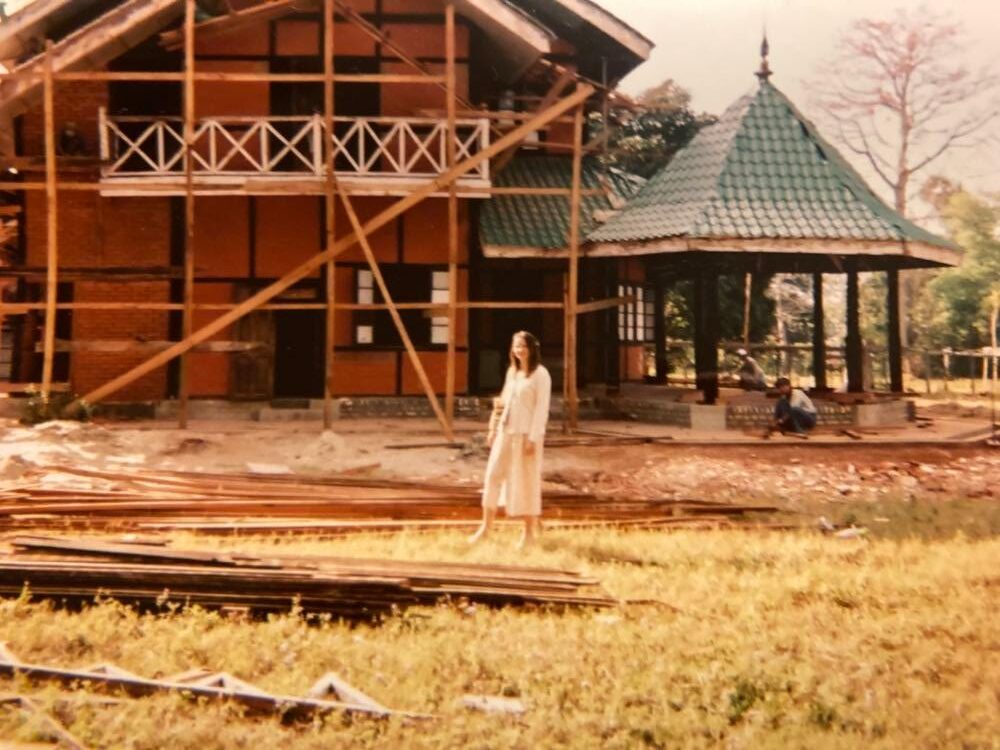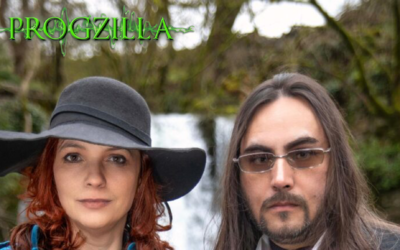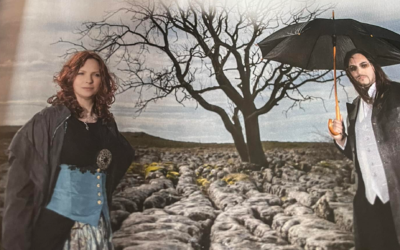Hello everybody, it’s about time we made some posts, so on this rather poignant day, I thought it would be good to explain the origins of our name.
I first came across the name “Candacraig” when my cousin, Anne, mentioned it. She used to sell vintage clothing at Norwich market and another trader who sold old photographs said he had a collection of old pictures of Burma. Knowing that she was born there he thought that she might be interested. She looked through them and came across one, telling the man “You won’t believe this but I used to live opposite this house.” Of course that was Candacraig and the house she lived opposite in was called Upper Fold, owned by my Uncle Victor who was a regional health inspector for the W.H.O.
My family’s connection with Burma (now known as Myanmar) began at the end of the 19th Century when my Great Grandfather, Thomas Nicholls, spent some time there. As the family owned a tobacco factory in Chester, we all presumed he went to Burma to oversee tobacco growing. However, after a bit of research we discovered he worked for the civil service and his visit to Burma was connected to that (Burma being a British colony at the time). What he did in the civil service and the reasons for his visit are still not known to us. What we do know is that he met and fell in love with a Burmese woman, Mah Lah, my great grandmother. They had two children, William, my grandfather and Katherine (Kitty). There has been much speculation about what led to the split, but it would seem that Thomas wanted to return to England and bring the family with him, whilst Mah Lah didn’t want to leave. She remained in Burma with the children and, as far as we know, that was the last Thomas saw of Mah Lah and William. However, Kitty, who married an English policeman in Burma, met him back in Chester.
The children showed very few Burmese characteristics and some nuns from a local convent were shocked to see these white kids playing in the dirt with other Burmese children. William and Kitty were “rescued” by the nuns and taken into the convent. It would seem that some sort of agreement was made with Mah Lah to allow the children to remain at the convent where they could receive an education.
William became an accountant and married Matilda (Tilly), another Anglo Burmese. Together they had nine children, the youngest of whom was Jimmy, my dad, born in January 1931. He was eleven years old when the Japanese invaded Burma. At the time, the family were living in Rangoon whilst William was away with work further north. The plan was for them all to make their separate ways to Myitkyna airport in the far north of Burma. William, already further north, made it to the airport and waited for the rest of the family to join him. Matilda left Rangoon with her youngest daughter, Theresa, her second son, Tony; who had learning difficulties and the youngest child, Jimmy. By this time, William and Matilda were already grandparents and Matilda had been left to care for four grandchildren; Marie (known as Diddy), Collette, Anne and Clare who was not much more than a baby. This rag tag assembly packed all their belongings onto a bullock cart and began the 730 mile trek to Myitkyna.
(You may be wondering what became of the other six children. The eldest child, Katherine (known as Babs] and the next child, Maude, were already married and living in India. The eldest son, Tom, had joined the army and later became a member of the Legendary Chindits (Long Range Penetration and Special Operations Unit). The remaining two sisters were Noreen and Esther who followed their older sisters into India. The second youngest child was Claude (known as Buster) who also went into the army, probably lying about his age as he was only sixteen)
After a number of adventures which included encounters with tigers, elephants, Dacoits (Burmese bandits) and the revelation that the bullocks they had bought were lazy, stubborn and useless, they were eventually overtaken by the Japanese. They were brought to Maymyo, a hill station in middle Burma where they lived under occupation. Word reached William that they had been captured and so he opted to make his way to Maymyo to be with them. He was forced to work for the Japanese and eventually died of cholera. Shortly after their capture, my cousin Clare also died, probably from cholera as well.
During the height of the conflict, the Japanese decided it was safer to intern all the civilians into a prison camp. All the British, Anglo Burmese and other non-Burmese nationals were moved into Alexander Barracks, just outside Maymyo, which had been the home of the Burmese Signals Corps. There have been many portrayals of life in a Japanese prison camp on film and television, many of which depict the brutal conditions the prisoners had to live in. But for my dad, whilst life was hard, for him it was a big adventure. He always said that Steven Spielberg’s “Empire of the Sun” came closest to realising his own experiences. The author J.G. Ballard was only a few months older than my dad; “I have—I won’t say happy—[but] not unpleasant memories of the camp… I remember a lot of the casual brutality and beatings-up that went on—but, at the same time, we children were playing a hundred and one games all the time!” Ballard, J.G. (1982). “From Shanghai to Shepperton”.
One day, all the Japanese guards suddenly left. The kids were all playing outside when a very shabby figure emerged from the jungle. It was an allied soldier. He walked up to a water trough and poured water over himself before drinking. All the children were fearful of this rather wild looking character with the huge gun slung over his shoulder. Dad being dad (he had been nicknamed Taro by the Japanese which means heroic boy), eventually approached the soldier and asked him if he was American. “Fuck off am I!” was the reply in a strong cockney accent. The soldier announced that Burma had been liberated and that troops were coming to bring supplies and medical aid.
The war had completely devastated Burma. People would find a home and occupy it. It would not be unusual to return home and find another family already living there. The Nicholls family became totally dispossessed and for this reason they all ended up living with Aunt Babs and my Uncle Victor, who had become a regional health inspector for the newly formed World Health Organisation. They lived in Upper Fold, the former home of Lieutenant Henry Morshead, a British civil servant who had been murdered nearby, the murderer never being found and the investigation subject to a suspected cover up. Upper Fold sat opposite the chummery Candacraig, just on the edge of the jungle.
A chummery was a building where, predominantly unmarried, young Western males would hang out to eat, drink, play billiards, tennis, cards, etc. The climate would have been unbearably hot for the mainly British colonials in Burma who would be overseeing trade in rubber, teak, oil and tobacco. Maymyo, being a hill station, had a much more temperate climate than the capital, Rangoon, so the British would retreat there during the height of summer and stay at chummeries like Candacraig.

In November 2000, the British Government established the Ex-gratia Payment for Far East POWs and Civilian Internees. The sum of £10,000 compensation was granted to all British citizens who had been imprisoned by the Japanese during WWII. Dad used this money to pay for him, my mum, my sister, Sharon and myself to accompany Diddy on a sentimental journey back to Burma. We spent three months there in February 2003, we left snow blizzards behind us and landed in searing sunshine at Mingaladon Airport, Rangoon (now called Yangon). The trip truly was a holiday of a lifetime with so many outstanding experiences; 16 hours by train from Rangoon to Mandalay watching rural Burma pass by my window, sailing down the Irrawaddy river to Pagan (an area littered with ancient pagodas), climbing to the top of a pagoda to watch the sun set in Pagan, visiting the Shwedagon Pagoda in the evening when no tourists attend and being the tallest person amongst over a thousand locals and even meeting long lost relatives, including my cousin William (the son of Tony who had died in the 80s in a road accident).
The second week was devoted entirely to staying in Maymyo, where we met more family friends, found houses that the family had stayed in and even found the Nissan hut in Alexander Barracks (just prior to it being demolished) where the family had been interned. During the whole time at Maymyo, we were lucky enough to stay at Candacraig. We were the only visitors to stay and had retired Gurkhas to protect us overnight from the rebel incursions which were happening nearby (although I’m not sure if this was to protect us or to stop us making contact with the rebels…. probably a bit of both!). Our stay in Maymyo was so poignant and had such an emotional impact upon us that, when it came to choosing a name for our duo, Candacraig seemed an obvious choice. Later we discovered that the Gaelic translation of Candacraig means “the head of the rock”. Seems pretty apt!
Seventy-nine years later, only three survivors of the prison camp remain with us; my cousins Collette and Anne and, most remarkably, my Aunt Theresa who celebrates her 104th birthday next month. Here’s to the survivors and victims of the forgotten war:




